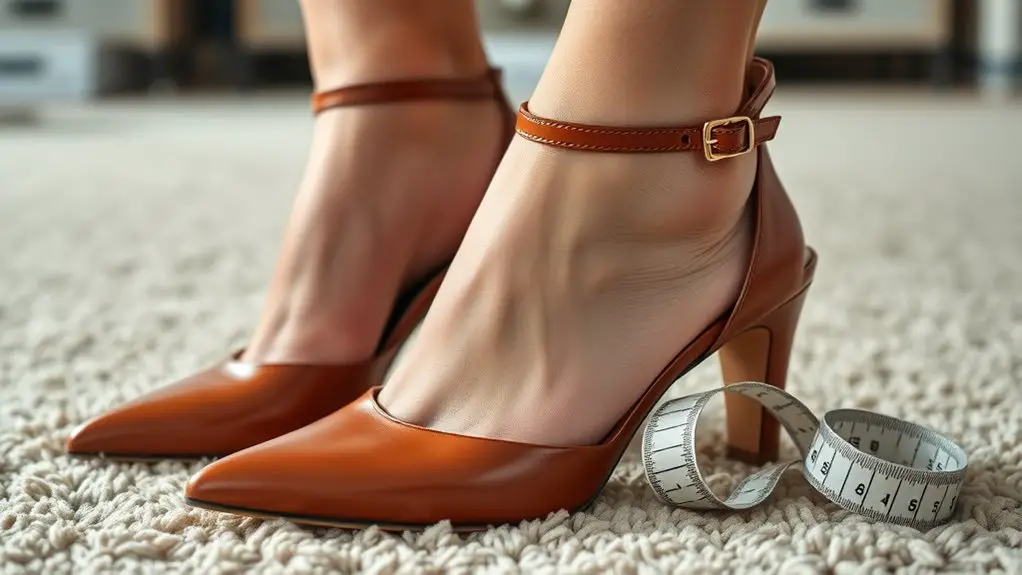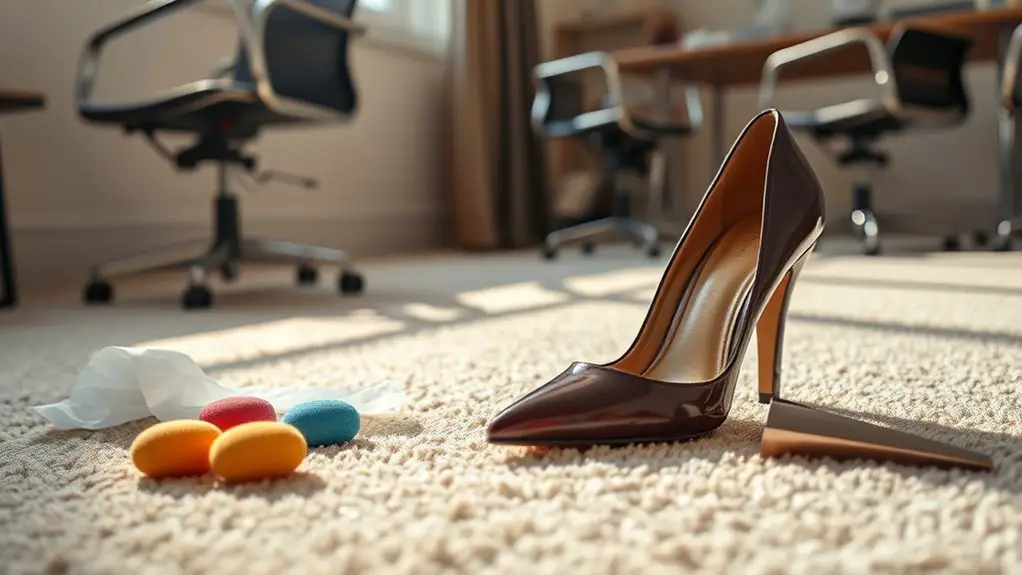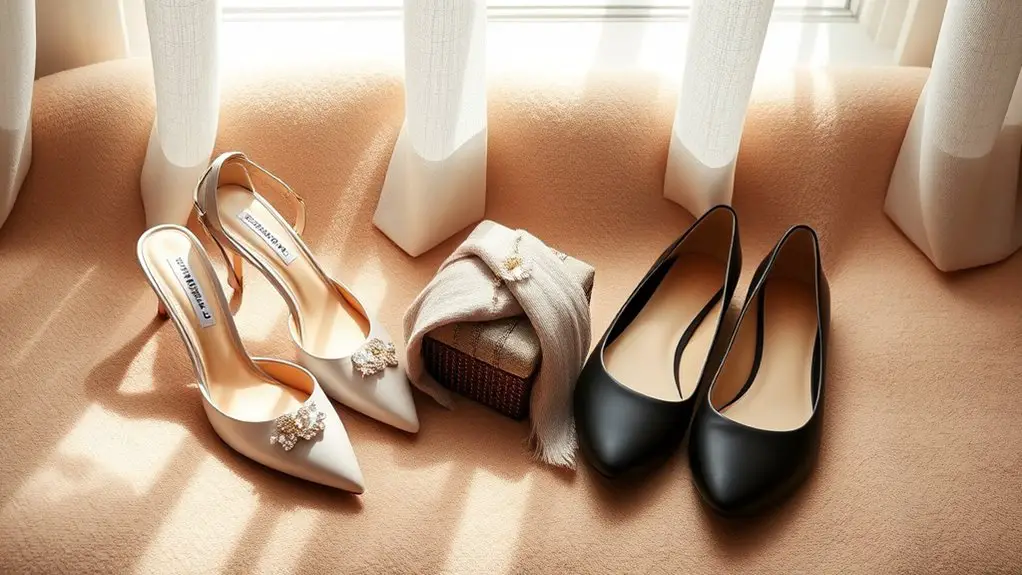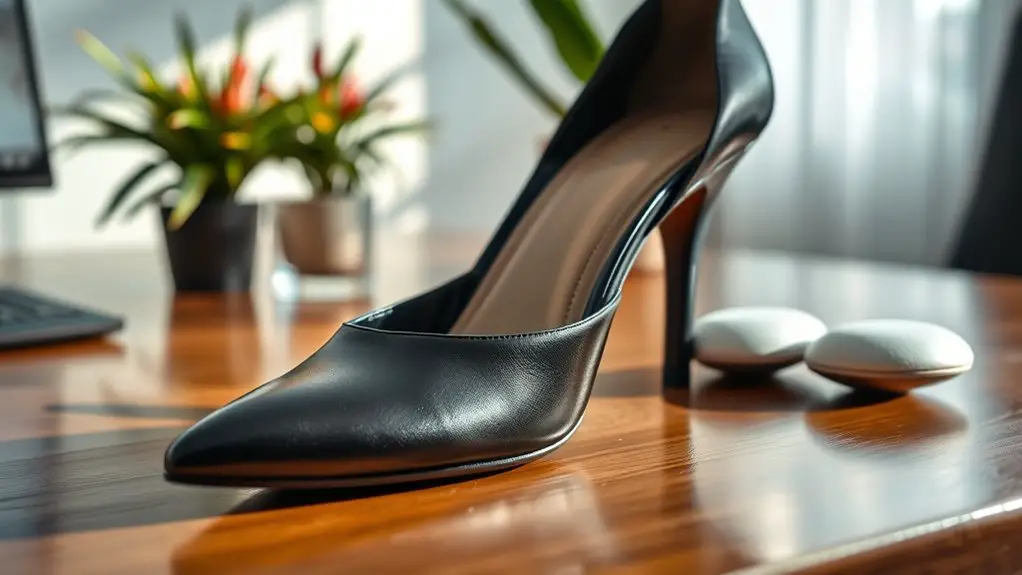To make heels more comfortable for work, start by choosing the right fit—measure your feet in the evening and consider width options if needed. Opt for cushioned insoles to provide shock absorption and arch support. Break them in gradually by wearing them for short periods and using stretching techniques. Utilize foot care products to keep your feet fresh and prevent irritation. You might also explore heel alternatives for added comfort and style, and there’s more to learn about enhancing that comfort.
Choose the Right Fit

When it comes to choosing the right fit for your work heels, getting it right is essential. Proper heel sizing can make or break your comfort throughout the day. Start by measuring your feet in the evening when they’re slightly swollen, as this gives you the most accurate size. Pay close attention to foot width as well; not all brands offer the same width options. If you’ve got wider feet, look for styles labeled as “wide” to avoid pinching.
It’s also important to take into account the heel height and the overall shape of the shoe. A well-fitted heel should have a snug fit without being overly tight. When you try on heels, walk around to verify they feel secure and comfortable. Remember, a great fit minimizes fatigue and allows you to focus on your work, rather than your aching feet. Prioritize fitting your heels correctly to guarantee long-lasting comfort.
Opt for Cushioned Insoles
Although you might love the look of your heels, comfort can quickly deteriorate without proper support, making cushioned insoles an essential investment. Opting for insoles with gel pads can greatly enhance your comfort level, absorbing shock and reducing pressure on your feet. Look for insoles that also provide adequate arch support; this can help alleviate fatigue and prevent pain during long hours of wear.
When selecting cushioned insoles, consider those designed specifically for heels, as they often feature a tapered design that fits seamlessly into your shoe. Installing these insoles is easy—just remove the existing insole, if any, and replace it with your new cushioned version. You’ll instantly notice a difference in how your heels feel, allowing you to focus on your work rather than foot discomfort. Investing in quality insoles is a small step that can make a big impact on your overall comfort throughout the day.
Break Them In Gradually

Breaking in your heels gradually is essential for ensuring long-term comfort. Start by wearing your new heels for short periods, gradually increasing the time you spend in them. This helps your feet adjust to the shoe’s shape without unnecessary pain. Incorporate stretching techniques for your feet and calves, like toe flexes and calf stretches, to enhance flexibility and reduce discomfort.
Another effective method is wearing socks with your heels at home. This not only provides extra cushioning but also helps stretch the material slightly, making them more accommodating. Aim for a balance—don’t rush the process, as forcing your feet into uncomfortable shoes can lead to blisters and other injuries.
Utilize Foot Care Products
Using foot care products can greatly enhance your comfort while wearing heels at work. One effective option is gel pads, which provide cushioning and support in key areas like the ball of your foot. These pads can help distribute your weight more evenly, reducing pressure and discomfort throughout the day.
Another useful product is foot spray. A good foot spray can keep your feet feeling fresh and dry, minimizing sweat and odor, especially during long hours at the office. Look for sprays that contain soothing ingredients to reduce irritation and provide relief.
Incorporating these products into your daily routine can make a significant difference. When you invest in gel pads and foot spray, you’re not just improving comfort; you’re also protecting your feet from potential long-term damage. Remember, a little preparation goes a long way in ensuring your heels don’t become a source of pain while you work.
Consider Heel Alternatives

If you’re struggling to stay comfortable in heels throughout your workday, it might be time to contemplate heel alternatives that can offer both style and support. Wedge shoes are a fantastic option, providing a stable base and distributing your weight more evenly. Block heels also deliver excellent support, allowing you to walk confidently without compromising on style. If you prefer a more delicate look, consider kitten heels; they’re low enough to minimize strain while still offering a polished appearance. Alternatively, platform shoes can give you extra height without the discomfort of traditional stilettos, as the thicker sole cushions your feet. By exploring these alternatives, you can enjoy the elegance of heels without sacrificing comfort. Choosing the right heel alternative can enhance your overall work experience, keeping you stylish and comfortable from morning meetings to after-hours events.
Frequently Asked Questions
How Often Should I Replace My Heels for Comfort?
Like a fine wine, your heels require careful consideration. You should replace them every 6-12 months, depending on wear. Remember these heel maintenance tips and heel lifespan considerations to guarantee your comfort and style endure.
Can Specific Heel Styles Be More Comfortable Than Others?
Yes, specific heel styles can be more comfortable. Block heels offer stability and distribute weight evenly, while wedge heels provide better arch support. Choosing the right style can greatly enhance your comfort throughout the day.
Are There Brands Known for Comfortable Work Heels?
You might think all heels are uncomfortable, but some brands prioritize comfort with innovative heel technology. Look into brands like Clarks, Vionic, or Naturalizer—they’re known for their stylish yet comfortable heels tailored for long workdays.
What Materials Are Best for Comfortable Heels?
When choosing comfortable heels, look for cushioning materials like memory foam and gel, which provide support. Additionally, flexible soles help with movement, reducing discomfort. Prioritizing these features can make a significant difference in your overall comfort.
Can I Wear Heels With Arch Support?
You can definitely wear heels with arch support. Look for designs featuring arch support options and heel cushioning. They help distribute weight evenly, offering better comfort and stability, making your time in heels more enjoyable.



